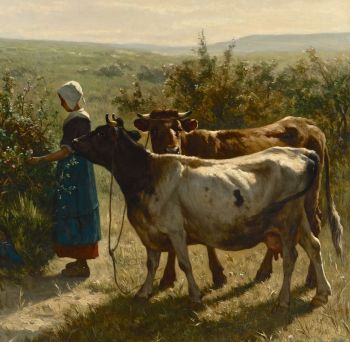Difference between revisions of "Cattle (domestic)"
Tao alexis (talk | contribs) |
Tao alexis (talk | contribs) |
||
| Line 1: | Line 1: | ||
| − | {| class="wikitable" style="float:right; margin-left: | + | {| class="wikitable" style="float:right; margin-left: 25px; text-align: center; background-color:#d4f2f2;" |
|+ Cattle | |+ Cattle | ||
| − | ! Detail !! Cow !! Bull | + | ! Detail !! style="width: 120px|Cow !! style="width: 120px|Bull |
|- | |- | ||
| '''Species''' || colspan="2"|[[Bovine|bovine]] | | '''Species''' || colspan="2"|[[Bovine|bovine]] | ||
Revision as of 19:29, 26 October 2023
| Detail | Cow | Bull |
|---|---|---|
| Species | bovine | |
| No. Appearing | 20-200 | 2-5 |
| Behaviour | herd | |
| Range | rural | |
| Size | 5 ft. at shoulder |
5½ ft. at shoulder |
| Weight | 1,000 lbs. | 1,330 lbs. |
| Intelligence | 1 | 2 |
| Armour Class | 7 | 6 |
| Hit Dice | 3 | 4+1 |
| Action Points | 5 | 5 |
| Max. Stride | 11 | 14 |
| THAC0 | 19 | 18 |
| Hp/Die | d4+d6 | d12 |
| Attack Forms | 2: horns | |
| Damage | horn (1-6) | horn (1-8) |
| Natural Abilities | stampede | charging, trampling |
Domestic cattle are descendants of auroch cattle, which were first tamed in the southern Caucasus and northern Mesopotamia about 7,500 years ago. Since that time, bred cattle have spread to every continent, where they thrive in nearly every climate. Much of the belligerence has been bred from the domestic species, so that they're largely indifferent to humanoids, providing they're not provoked. Some bulls still have a potential for aggression.
Behaviour
If cornered, cattle will stand and fight, but given the opportunity they prefer to move off at a steady pace until left alone. Herders are able to keep them moving through calling, tapping them along or "driving" them from horseback.
Ordinarily, when kept on a farm, dairy cows are brought in from the pasture for milking in the evenings and let out on the field again after being milked again in the morning. Beef cows may be allowed to remain overnight on pastures that have been fenced in.
They use much of their day to eat and lounge — when driven too hard, they will grow "nervous" and sensitive to loud noises or abrupt movements. On long drives, steps are taken to ensure that cattle remain calm and are allowed periods to relax — as there's a danger that a cattle herd will break into a run, starting a stampede.
When stampeding, a body of cattle may swing in any direction, even turning back on themselves. They'll wreck wagons, buildings, trees and anything else in their way. A character in their path can be easily killed by multiple horns and collective incidental damage. For any character caught in a stampede, allow one horn attack will occur per every 20 cows, while every cow is assessed for causing damage from their weight.
Bulls
Bulls are more muscular and aggressive than cows, playing a significant role in beef ranching, dairy farming and other cultural activities like bullfighting. A male bull that's been castrated is called a "steer," "ox" or "bullock." Bulls have a large, bony head with protective ridges over the eyes. Their horns are thicker and shorter than thoses of cows, curving outwards in a flat arc rather than upwards in a lyre-shape.
They require careful handling; if angered, they'll drop their heads and charge, gaining +2 to hit and striking with +1 damage to each horn that hits. Adjacent creatures are subject to incidental damage and those who are stunned will be trampled upon for an additional 2-8 damage.
See Bestiary
